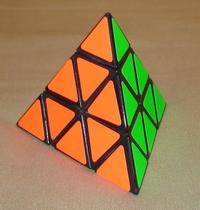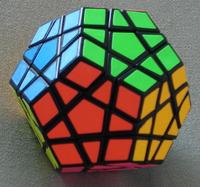
The Rubik's Cube is a 3-D combination puzzle originally invented in 1974 by Hungarian sculptor and professor of architecture Ernő Rubik. Originally called the Magic Cube, the puzzle was licensed by Rubik to be sold by Ideal Toy Corp in 1980 via businessman Tibor Laczi and Seven Towns founder Tom Kremer. The cube was released internationally in 1980 and became one of the most recognized icons in popular culture. It won the 1980 German Game of the Year special award for Best Puzzle. As of January 2009, 350 million cubes had been sold worldwide, making it the world's bestselling puzzle game and bestselling toy.

The Rubik's Revenge is a 4×4×4 version of the Rubik's Cube. It was released in 1981. Invented by Péter Sebestény, the Rubik's Revenge was nearly called the Sebestény Cube until a somewhat last-minute decision changed the puzzle's name to attract fans of the original Rubik's Cube. Unlike the original puzzle, it has no fixed facets: the centre facets are free to move to different positions.

The Pyraminx is a regular tetrahedron puzzle in the style of Rubik's Cube. It was made and patented by Uwe Mèffert after the original 3 layered Rubik's Cube by Ernő Rubik, and introduced by Tomy Toys of Japan in 1981.

The Megaminx or Mégaminx is a dodecahedron-shaped puzzle similar to the Rubik's Cube. It has a total of 50 movable pieces to rearrange, compared to the 20 movable pieces of the Rubik's Cube.

Uwe Mèffert was a German puzzle designer and inventor. He manufactured and sold mechanical puzzles in the style of Rubik's Cube since the Cube craze of the 1980s. His first design was the Pyraminx – which he had developed before the original Rubik's cube was invented. He created his own puzzle company and helped bring to market the Megaminx, Skewb, Skewb Diamond and many other puzzles.

The Pyramorphix, also called Pyramorphinx, is a tetrahedral puzzle similar to the Rubik's Cube. It has a total of 8 movable pieces to rearrange, compared to the 20 of the Rubik's Cube. Although it looks like a trivially simple version of the Pyraminx, it is an edge-turning puzzle with the mechanism identical to that of the Pocket Cube.

A combination puzzle, also known as a sequential move puzzle, is a puzzle which consists of a set of pieces which can be manipulated into different combinations by a group of operations. Many such puzzles are mechanical puzzles of polyhedral shape, consisting of multiple layers of pieces along each axis which can rotate independently of each other. Collectively known as twisty puzzles, the archetype of this kind of puzzle is the Rubik's Cube. Each rotating side is usually marked with different colours, intended to be scrambled, then 'solved' by a sequence of moves that sort the facets by colour. As a generalisation, combination puzzles also include mathematically defined examples that have not been, or are impossible to, physically construct.

The Rubik's Cube is the original and best known of the three-dimensional sequential move puzzles. There have been many virtual implementations of this puzzle in software. It is a natural extension to create sequential move puzzles in more than three dimensions. Although no such puzzle could ever be physically constructed, the rules of how they operate are quite rigorously defined mathematically and are analogous to the rules found in three-dimensional geometry. Hence, they can be simulated by software. As with the mechanical sequential move puzzles, there are records for solvers, although not yet the same degree of competitive organisation.

The Impossiball is a rounded icosahedral puzzle similar to the Rubik's Cube. It has a total of 20 movable pieces to rearrange, which is the same as the Rubik's Cube, but all of the Impossiball's pieces are corners, like the Pocket Cube.

The Pyraminx Crystal is a dodecahedral puzzle similar to the Rubik's Cube and the Megaminx. It is manufactured by Uwe Mèffert and has been sold in his puzzle shop since 2008.

The Void Cube is a 3-D mechanical puzzle similar to a Rubik's Cube, with the notable difference being that the center pieces are missing, which causes the puzzle to resemble a level 1 Menger sponge. The core used on the Rubik's Cube is also absent, creating holes straight through the cube on all three axes. Due to the restricted volume of the puzzle it employs an entirely different structural mechanism from a regular Rubik's Cube, though the possible moves are the same. The Void Cube was invented by Katsuhiko Okamoto. Gentosha Education, in Japan, holds the license to manufacture official Void Cubes. These official designs are also sold under the Rubik's brand, owned by Spin Master Ltd., and workalikes are available from a variety of manufacturers. Speed-solving the Void Cube is common in exhibition but is not an official World Cube Association competition event.

The Helicopter Cube is a Rubik's Cube-like puzzle invented by Adam G. Cowan in 2005 and built in 2006. It is also in the shape of a cube. At first glance, the Helicopter Cube may seem like a combination of the 2x2x2 and the Skewb, but it actually cuts differently, and twists around cube edges rather than cube faces. The purpose of the puzzle is to scramble the colors, and then restore them back to their original state of a single color per face.

Alexander's Star is a puzzle similar to the Rubik's Cube, in the shape of a great dodecahedron.
The original Rubik's cube was a mechanical 3×3×3 cube puzzle invented in 1974 by the Hungarian sculptor and professor of architecture Ernő Rubik. Extensions of the Rubik's cube have been around for a long time and come in both hardware and software forms. The major extension have been the availability of cubes of larger size and the availability of the more complex cubes with marked centres. The properties of Rubik’s family cubes of any size together with some special attention to software cubes is the main focus of this article. Many properties are mathematical in nature and are functions of the cube size variable.

Tony Fisher is a British puzzle designer who specialises in creating custom rotational puzzles. He is acknowledged by cubing enthusiasts as a pioneer in the creation of new puzzle designs and new manufacturing techniques. In 2017 the Guinness Book of World Records acknowledged Fisher as the creator of the world's largest Rubik's cube.

A Tuttminx is a Rubik's Cube-like twisty puzzle, in the shape of a truncated icosahedron. It was invented by Lee Tutt in 2005. It has a total of 150 movable pieces to rearrange, compared to 20 movable pieces of the Rubik’s Cube.

Oskar van Deventer is a Dutch puzzle maker. He prototypes puzzles using 3D printing. His work combines mathematics, physics, and design, and he collaborates at academic institutions. Many of his combination puzzles are in mass production by Uwe Mèffert and WitEden. Oskar van Deventer has also designed puzzles for Hanayama.

The Pyraminx Duo is a tetrahedral twisty puzzle in the style of the Rubik's Cube. It was suggested by Rob Stegmann, invented by Oskar van Deventer, and has now been mass-produced by Meffert's.

The Gear Cube is a 3-D combination puzzle designed and created by Dutch puzzle maker Oskar van Deventer based on an idea by Bram Cohen. It was initially produced by Shapeways in 2009 and known as "Caution Cube" due to the likelihood of getting one's fingers stuck between the gears while speedcubing. Later, in 2010, it was mass-produced by Meffert's as the "Gear Cube".

The Dino Cube is a cubic twisty puzzle in the style of the Rubik's Cube. It was invented in 1985 by Robert Webb, however it was not mass-produced until ten years later. It has a total of 12 external movable pieces to rearrange, compared to 20 movable pieces on the Rubik's Cube.

























